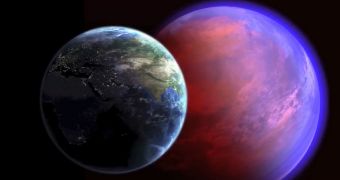A new study on the super-Earth-class extrasolar planet 55 Cancri e reveals that the alien world is not the extremely hot desert that astronomers first made it out to be. The exoplanet is apparently wetter than anyone believed, which makes it extremely weird.
The reason why experts were so surprised at the conclusions they derived from the new investigation is that the world orbits extremely close to its parent star. At such close proximity, planets are usually tidally-locked, similarly to how the Moon is to the Earth.
55 Cancri e made it on astronomers' golden list as soon as they discovered it. Located in the constellation Cancer, the object is just 40 light-years away, which basically puts it in our cosmic backyard. The thing that sets it apart from Earth is its extreme density.
It's also important to note here that while Earth takes ~365 days to orbit the Sun once, the exoplanet needs just 18 hours. Mercury, the closest planet to the Sun in our solar system, needs 88 days to complete a full orbit, Space reports.
This puts 55 Cancri e around 26 times closer to its parent star than Mercury. Based on this information, astronomers estimated that average temperatures on the alien world reached as high as 4,800 degrees Fahrenheit (roughly 2,700 degrees Celsius).
Studies conducted using the NASA Spitzer Space Telescope, which surveys the sky in infrared wavelengths, show a more intriguing picture of the exoplanet. Experts were able to conclude that 55 Cancri e is around 7.8 times heavier than Earth, as well as twice larger in diameter.
These size, volume and density values put it squarely in the super-Earth class. “Only a handful of known super-Earths, however, cross the face of their stars as viewed from our vantage point in the cosmos, so 55 Cancri e is better understood than most,” NASA astronomer Tony Phillips explains.
What Spitzer data suggest is that around 20 percent of the entire planet is made up of light compounds and chemical elements, water included. Due to extreme temperatures and pressure, these elements are forced into a supercritical fluid state.
Scientists best describe this state as a liquid-like gas exposed to high pressure and temperature conditions. On 55 Cancri e, chemicals in this state may be reaching out to the surface from rocks.
While there is no chance that the exoplanet is inhabitable, astronomers say that it provides a very interesting study subject. Their studies are bound to be made easier by the fact that this world is very close to our own.

 14 DAY TRIAL //
14 DAY TRIAL //